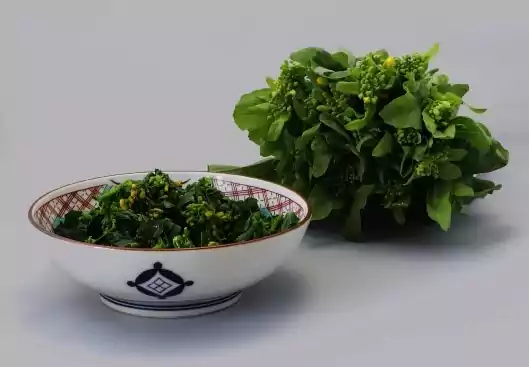Eating seasonally is a wonderful way to get the nutrients you need, while also connecting you to the changes that occur throughout the year and our cultural traditions that reflect these changes. Chankonabe is eaten to celebrate the start of the sumo wrestling tournament, and chirashizushi is eaten to celebrate Hinamatsuri. Ingredients such as asari and nanohana are in season, giving us the goodness we need to help avoid colds and other illnesses. On top of this, eating seasonally helps us be more sustainable since it requires less energy to grow, and provides the ingredients when they occur naturally and locally. So, if you’re looking to learn about spring foods in Japan, please read on! And, if you enjoy cooking, these might even inspire you to get creative in the kitchen of your Village House apartment!

Chirashizushi

Often served on the 3rd of March for Hinamatsuri, the Dolls Festival, Chirashizushi is one of the most popular spring dishes in Japan. For the Dolls Festival, many families choose to decorate Hina Dolls and enjoy Chirashizushi alongside traditional treats such as strawberry daifuku.
Chirashizushi is exactly what the name says, ‘chirashi’ means “to scatter”, and this dish is essentially deconstructed sushi. Fish is scattered over sushi rice with vinegar on a plate, often mixed with vegetables and other garnishes.
The dish often includes ingredients such as salmon roe, shrimp, crab, egg, snow peas, lotus root, bamboo shoots, shiitake, and plenty more. Some ingredients are mixed into the rice, and some are scattered over the top decoratively. Chirashizushi has various names depending on the region, barazushi, gomoku sushi, and gomoku chirashi are all variations of the same dish.
Chankonabe

Chankonabe is famously eaten by sumo wrestlers on a daily basis as the hefty dish that helps provide the sustenance they need and is eaten to gain weight. It is just as popular to non-athletes as well and can be enjoyed all year round. During this time of the year, however, in order to welcome the start of the spring sumo tournament, and to warm you up as it still can be chilly, we particularly recommend you try out this delicacy.
The hot pot dish has a lot of different toppings, including seafood and meat, meatballs, tofu, vegetables such as scallions, carrots, shiitake, and radishes. The toppings are all simmered in a chicken or miso broth, or dashi with mirin to flavor. The dish incorporates what is available to the cook, so ingredients and quantities vary. Typically, during the sumo tournament, Chankonabe is made with chicken to signify how a sumo wrestler should be on two legs like a chicken, rather than on all fours like other animals.
One of the best places to enjoy Chankonabe is in the restaurants of retired sumo wrestlers who then specialize in the dish.
Nanohana

A harbinger of spring, Nanohana, although bitter in taste, is a sweet sign of the warmth that is to come when it appears in supermarkets from December through to March. The name translates to mean “the flowers of a leafy vegetable”, and it refers to rapeseed flowers. Nanohana is eaten to cleanse the body of winter toxins and awaken it, starting anew for spring.
You eat the top part of the rapeseed plant, so the flower and some leaves and stalks. It is full of vitamins and minerals with various benefits, helping to build up your body’s strength and resistance to colds.
One of the most popular ways to eat it is sautéed in mustard and soy sauce, alternatively you could add bacon to the mix, as well as garlic. Nanohana can also be boiled and served with dashi and dried bonito flakes.
We are now more aware of how important it is to build up our body’s resistance to illness, so eating this vegetable is a great way to be a bit healthier!
Asari Clams

In spring the sea waters begin to warm again, indicating the start of clam season, where they are fished out of inlets. Rich in B2, iron, and calcium, and low in fat, they are exceptionally nutritious.
Asari no sakemushi is a simple dish incorporating clams, combining them with sake and scallions to make a clam soup. You can add to the dish by incorporating butter, ginger, or red chili peppers.
Some other popular dishes incorporating Asari clams are sautéing them in garlic and olive oil and adding white wine and pasta to make vongole. You can also boil them in water and add miso flakes for a miso clam soup. Asari miso is rich in protein and vitamins and is often served in restaurants in spring.
Asari clams should be eaten as soon as possible, so we recommend buying them only on the day that you are planning to eat them.
Strawberries

Strawberries have a unique history in Japan. Though they are naturally in season in spring, from January to early May. However, with the popularity of strawberries in Christmas cakes and other winter treats, they have become a popular fruit in winter, so many farmers grow them in polytunnels to provide strawberries for the winter months.
Springtime, nevertheless, is the strawberry season. You can enjoy some of the most succulent and sweet strawberries across the world in Japan. Various strawberry farms even let you pick your own strawberries and eat them there or take them home. This is a great activity for families, friends, and couples to make the most of the mild spring weather and spend some time outside. If you can’t get enough of this tasty fruit, some cafés offer all-you-can-eat strawberry sessions too.

You can find delicious ichigo daifuku throughout the year, but they are particularly delicious in the spring months when strawberries are naturally in season. This traditional Japanese sweet treat, made from mochi stuffed with red bean paste and a strawberry are popular through winter and spring.
No matter if you are planning to go out to eat these foods at a restaurant or try cooking some of them at home, we hope you will enjoy these popular spring dishes. Please also check out our sakura snack guide to celebrate one of the most joyous times of the year when the cherry blossoms bloom.
Related articles:
- Sakura Snacks and Spring Themed Food in Japan
- Top 5 Refreshing Japanese Summer Foods You Need to Try
- Top 5 Foods in Shizuoka Prefecture
- Top Five Foods in Aichi Prefecture
- Top Five Hokkaido Foods


